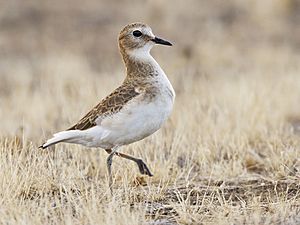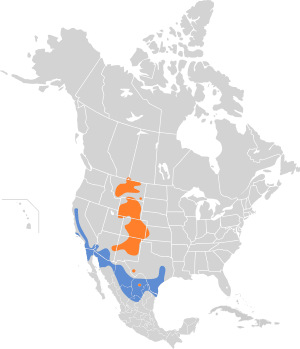Mountain plover facts for kids
Quick facts for kids Mountain plover |
|
|---|---|
 |
|
| Conservation status | |
| Scientific classification | |
 |
The mountain plover (Charadrius montanus) is a medium-sized bird that lives on the ground. It belongs to the plover family. Even though its name has "mountain" in it, this bird actually prefers flat, dry land. You usually won't find it near water. Instead, it likes areas with short grass and bare ground, often where animals have grazed.
Contents
About the Mountain Plover
The name "plover" comes from a Latin word meaning "rain." In old England, some birds were called plovers because they returned in spring with the rain. In 1832, a naturalist named John Kirk Townsend saw this bird near the Rocky Mountains. He thought all these birds lived in mountains, so he gave it the name "mountain plover."
These birds are about 8 to 9.5 inches (20 to 24 cm) long. They weigh around 3.7 ounces (105 grams). Their wings can spread out to about 17.5 to 19.5 inches (44.5 to 49.5 cm). Both male and female mountain plovers are the same size.
They look like other plovers, but they don't have a dark band across their chest. Their upper feathers are sandy brown, and their belly and face are whitish. They have some black feathers on their forehead and a black stripe from each eye to their beak. This stripe might be brown or hard to see in winter.
The mountain plover is much quieter than its relative, the killdeer. Its calls are soft whistles that can change. When they are trying to find a mate, they make a sound that some people say sounds like a cow mooing far away.
Where Mountain Plovers Live
Mountain plovers breed in the high plains of North America. This includes parts of southeastern Alberta and southwestern Saskatchewan in Canada. They also breed in the United States, from northern New Mexico to the Texas panhandle. There's also a small group in the Davis Mountains of West Texas.
About 85 percent of these birds spend their winters in California. They go to the San Joaquin and Imperial Valleys. Their winter home also stretches along the U.S.-Mexican border, mostly on the Mexican side.
For breeding, a mountain plover needs about 70 acres of land. For just living, they need about 25 acres. Around late July, after breeding, they fly to the southern Great Plains. Not much is known about their exact movements then. By early November, most fly south and west to their winter spots. Their spring flight back to breeding areas seems to be direct and without stops.
Ecology and Life Cycle
Mountain plovers mostly eat insects and other small bugs. They often hang out near farm animals like cows. These animals stir up insects, making it easier for the plovers to find food.
Nesting and Reproduction
Mountain plovers build their nests on bare ground in early spring, usually in April in northern Colorado. Their breeding area needs to have bare ground with short, thin plants. Plovers often choose places where bison and black-tailed prairie dogs live. These animals eat the plants, keeping the grass short.
Plovers like to nest near prairie dog colonies. This is because prairie dogs dig and eat plants, which creates more bare soil. This bare soil is perfect for plover nests. It's believed that plovers like bare ground because they blend in, hiding from birds that might try to eat them. Short plants also help them spot predators on the ground. It also makes it easier for them to see insects to eat.
A mountain plover nest has a survival rate that can be anywhere from 26% to 65%. This big difference might be because of the weather. Nests in colder, drier places have a better chance of surviving. Hot weather can harm the eggs. Wet weather might help predators smell the nests more easily.
Predators are the biggest reason why nests are destroyed. Some common predators include coyotes, snakes, and swift foxes.
The breeding season lasts through the summer, ending in late July or early August. The male bird will claim a territory and perform dances to attract a female. Females lay several groups of eggs, called clutches. Each clutch usually has three off-white eggs with black spots. Eggs laid later in the season tend to be smaller. This is because laying many eggs takes a lot of energy from the female.
Both male and female mountain plovers take turns sitting on the eggs. The female lays her first clutch of eggs and leaves the male to take care of them. Then, she lays a second clutch, which she takes care of herself. This way, more chicks can hatch compared to other birds where both parents care for only one group of eggs. A female can mate with several males and have many nests in one breeding season. This would mean more chicks, but it's very tiring for the female. So, it's more common for a female to lay only two clutches.
If the eggs survive predators, they hatch in 28 to 31 days. The baby birds leave the nest within a few hours. In the next two or three days, the family usually moves a short distance away. They go to a good feeding area, often near a water tank for farm animals.
Population Status
The number of adult mountain plovers is thought to be between 11,000 and 14,000. The total population is about 15,000 to 20,000 birds. However, a report in 2009 showed that the mountain plover population is seriously decreasing.
The number of mountain plovers is going down because their living spaces are being changed. This includes land being used for farming, cities growing, and too much grazing by animals. In 1999, there was a suggestion to list them as a threatened species. In 2009, the U.S. Fish and Wildlife Service proposed to officially list the mountain plover as threatened under the Endangered Species Act.
Protecting Mountain Plovers
A report from 2005 looked at mountain plovers and prairie dogs in Montana. It found that mountain plovers like to build their homes in prairie dog colonies. This means that if there are more prairie dogs, there will likely be more mountain plovers. This information is very helpful for saving the plovers. Losing prairie dog colonies is a big danger to mountain plovers in Montana. If we can protect prairie dog colonies, we have a better chance of saving the plovers.
Other ideas for protecting them include saving their remaining breeding and winter homes. It's also important to stop turning grasslands into farmland.
The link between mountain plovers and prairie dogs is very strong in Montana. But it's less strong in Colorado and Wyoming. In places where prairie dogs are not as common, things like fire or grazing can help. They keep the plants short, which creates good nesting spots for plovers. Short-grass prairie areas are best for creating plover habitats. A large part of the plover population breeds in Montana, so protecting this area is very important.
The number of plovers in Wyoming is lower than in other states. However, Wyoming has large areas of grazed land that are still mostly untouched. These areas will likely become very important in the future as cities and farms continue to grow in nearby states.
In Oklahoma, most mountain plovers are found in farm fields. These fields are often bare and flat. Plovers prefer land with clay soil. Sandy soils are less good because sand can blow around, covering nests and irritating their eyes. More study is needed to help keep mountain plovers in Oklahoma.
We need to keep watching and studying mountain plover populations. This will help us understand how to support their survival. Plovers are important to the environment because they show how healthy their habitats are. Local land managers can help plovers by protecting their land and prairie dog colonies from human activities like mining. They should also keep an eye on the size and health of good plover habitats in each area.
When fewer baby chicks survive, it adds to the population decline. Helping more eggs hatch doesn't help as much as making sure the young chicks survive after hatching. We can help the population grow more by learning about what happens to chicks after they hatch from their eggs.
See also
 In Spanish: Chorlito llanero para niños
In Spanish: Chorlito llanero para niños


